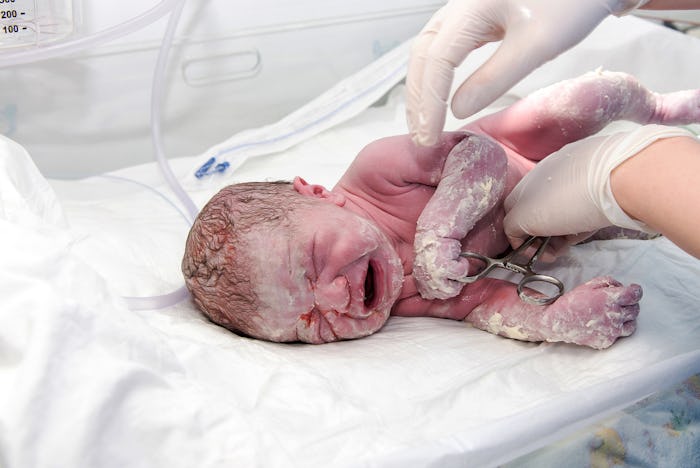Life

Don't Panic — Your Baby May Look Purple When They're Born & Here's Why
Long before I gave birth for the first time, I had a close friend who delivered her son while living overseas. When the picture she emailed popped up on my screen, I sat horrified and gaping — her newborn was an alarming shade of bluish-purple! The email said absolutely nothing about any difficulties or concerns with the birth, leaving me baffled, curious, and hoping everything was OK. But as I came into motherhood myself, I learned that this was not an unusual phenomenon, and is not a reason to panic. So why is your baby purple when they're born? Experts say there are several possibilities.
According to the Stanford Children's Health network, your baby's coloration can vary depending on factors such as ethnicity, temperature, and whether or not they're crying. When a baby is newly born, their skin will be dark red to purple, which lightens as they begin to breathe air and as the first day passes. But if your little one's hands and feet stay blue for longer than that, don't sweat it: It's merely because of the immature blood circulation.
In an exclusive interview with Romper, Dr. Deane Waldman, author of the e-book series: "Restoring Care to American Healthcare," explains that there are three causes for a bluish-purple discoloration in newborns, all having to do with oxygen. Most commonly, he says, "You can have normal oxygen in the arterial blood but slowing of the (normally blue) venous blood in the skin so that the baby looks purplish-blue — but the internal organs are all getting adequate oxygen."
In retrospect, I can see that this must have been the case for my friend's newborn son, which is why her doctor wasn't concerned about it even though it seemed frightening to me. In most cases, purple newborns don't even warrant a raised eyebrow from a medical professional.
Unfortunately, however, there are exceptions. The other two possible causes that Waldman addresses are more serious. He says an infant might be purple or blue because of low oxygen in the blood due to a lung problem — the sound of which alone is enough to make a parent faint in fear — but Waldman says several such lung problems are temporary.
The most severe cause for concern, and the one that parents fear most, is the possibility of low oxygen in the blood due to a congential heart problem, Waldman tells Romper.
Addressing these specific concerns, high risk pregnancy expert Sasha Davidson, MD tells Romper there are various types of heart conditions that could contribute to a purple color at birth: Structural cardiac defect, ventilation and perfusion challenges, decreased oxygen exchange, transient pulmonary tachypnea and other cardio-pulmonary changes of the newborn.
So how do you know when to worry? To start, take your doctor's cues; she likely sees plenty of healthy babies born purple every day. But medical malpractice attorney Annamarie Bondi-Stoddard advises parents to be fully informed participants in their baby's birth. In her experience, she tells Romper, "Babies' purplish color turns to pink as the blood circulates. If the baby appears blue, it could be signs of oxygen deprivation. Other signs to look for can be an absent or weak cry, low heart rate, limpness, or lack of response to stimulation. In this case the baby may need oxygen and other types of resuscitation."
If your baby is born purple, the odds are they are perfectly fine. While it's important to be educated on other signs to look for just in case, the body of your little bundle of joy is probably just learning to adapt to the outside world. So you can both breathe easy.
Check out Romper's new video series, Romper's Doula Diaries:
Check out the entire Romper's Doula Diaries series and other videos on Facebook and the Bustle app across Apple TV, Roku, and Amazon Fire TV.